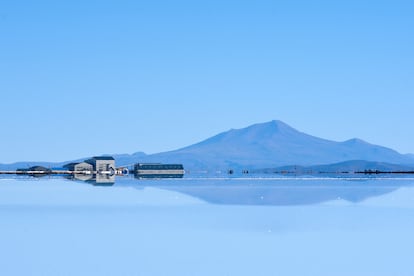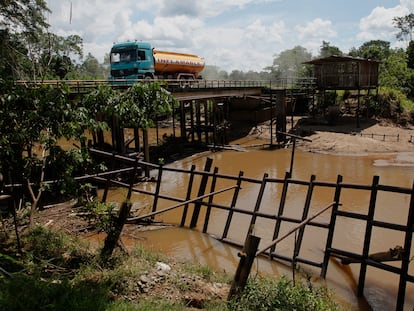In a chaotic world, an indispensable hemisphere
America’s future lies with the Americas — a powerful reality policymakers and political leaders alike must embrace in the face of a chaotic world

With today’s frontpage global challenges — Russia’s war of aggression in Ukraine; the conflict between Israel and Hamas; tensions between Iran and Israel; deteriorating U.S.-China relations; an intensifying climate crisis; and historic human displacement — the Americas is regularly overlooked as if it were a peripheral world apart; at most, it grabs attention as an arena for great power competition.
It is much more than that. It is a region the United States must embrace as an indispensable part of the world critical to ensuring economic competitiveness; navigating the energy transition and climate crisis; and achieving food security and ordered human mobility.
U.S. economic vibrancy cannot exist without its North American neighbors. Mexico and Canada are the United States’ No. 1 and No. 3 trade partners and critical industries like the automotive, aeronautical and energy sectors depend upon partnerships with those countries as production has become fundamentally North American. Creating additional resilient, critical supply chains for semiconductors and medical goods — to name only two — is impossible without them.
North America’s role is embedded not only in the USMCA — up for review in 2026 — but also in U.S. industrial policy. Fulfilling the promise of “nearshoring” will require expanding North American incentives in the Inflation Reduction Act and the CHIPS and Science Act and the complimentary scaling of multilateral and bilateral development finance to FTA partners — and others — in the Americas.
The Americas are home to more than 53% and approximately 40% of the world’s lithium and copper, both essential for electric vehicle batteries and renewable energy storage. IRA tax incentives cover some FTA partners like Mexico, Canada and Chile, but leave critical reserves in Argentina and Brazil exposed to unchallenged Chinese exploitation. The U.S. Development Finance Corporation has made an initial investment in Brazil’s lithium sector, but to secure U.S. interests, investments must be scaled and critical mineral agreements like those with the EU and Japan must be reached with Argentina and Brazil.
South America with an energy matrix built upon renewables is a potential global leader in green hydrogen, another critical energy transition linchpin. As home to roughly 30% of the world’s fresh water, 40% of its biodiversity, and vast carbon capture capacity rooted in its forests — chiefly, but not exclusively, the Amazon — it is also indispensable to meeting Paris Agreement climate targets. Converting these resources into fiscal benefits as Ecuador’s historic debt-for-nature swap did must be scaled and replicated. Doing so requires ensuring the region’s multilateral development banks are fully capitalized and aligned with U.S. interests.
As with the energy transition and the climate crisis, much of the solution to deepening food insecurity lies in the Americas. Together, the United States and the rest of the countries of the Western Hemisphere account for more than two thirds of the world’s agricultural and fishery production. Brazil ranks third globally to the United States and the European Union. The opportunity to leverage AgTech for the benefit of the hungry (and the environment) in the Americas and well beyond is nearly limitless.
With more than 20% of the world’s displaced population from a region that accounts for only 8% of the world’s population, the countries of Latin America and the Caribbean have set an example when it comes to migration management. Faced with meltdowns in Venezuela, Cuba, Haiti and Nicaragua and the economic fallout of the Covid-19 pandemic, communities across the Americas have eschewed harsh border enforcement and refugee camps in favor of integration and inclusion — with stunning success as more than 80% of Latin America and the Caribbean’s displaced population has remained in the region.
Colombia’s unprecedented 10-year protective status for Venezuelans and Mexico’s embrace, albeit uneven, of becoming a global leader in receiving asylum claims are two, among many, powerful examples to follow. The Los Angeles Declaration for Migration and Protection’s layered approach to mitigating, managing and ordering migration agreed to by 22 countries across the Americas sets a clear path for the United States and its neighbors to maximize the benefits of migration for all in the Americas and establish durable order at the U.S.-Mexico border.
Finally, in a multipolar world in which authoritarianism, populism, and illiberal democracy are growing and global freedom has been declining for 18 consecutive years, to live alongside a region in which 70% of its inhabitants lives in free democracies, even as democracy is under strain, is a valuable resource for the United States.
The Americas holds great promise to achieve core U.S. and global interests. Unlocking it — and overcoming the region’s undeniable challenges —requires placing the Americas in its rightful place on the U.S. global agenda — at the center.
Roberta Jacobson served as US Ambassador Mexico and Assistant Secretary of State for Western Hemisphere Affairs; Dan Restrepo served as Special Assistant to the President for the Western Hemisphere. Both are founding partners of Dinámica Americas.
Sign up for our weekly newsletter to get more English-language news coverage from EL PAÍS USA Edition
Tu suscripción se está usando en otro dispositivo
¿Quieres añadir otro usuario a tu suscripción?
Si continúas leyendo en este dispositivo, no se podrá leer en el otro.
FlechaTu suscripción se está usando en otro dispositivo y solo puedes acceder a EL PAÍS desde un dispositivo a la vez.
Si quieres compartir tu cuenta, cambia tu suscripción a la modalidad Premium, así podrás añadir otro usuario. Cada uno accederá con su propia cuenta de email, lo que os permitirá personalizar vuestra experiencia en EL PAÍS.
¿Tienes una suscripción de empresa? Accede aquí para contratar más cuentas.
En el caso de no saber quién está usando tu cuenta, te recomendamos cambiar tu contraseña aquí.
Si decides continuar compartiendo tu cuenta, este mensaje se mostrará en tu dispositivo y en el de la otra persona que está usando tu cuenta de forma indefinida, afectando a tu experiencia de lectura. Puedes consultar aquí los términos y condiciones de la suscripción digital.
More information
Archived In
Últimas noticias
Most viewed
- David King, chemist: ‘There are scientists studying how to cool the planet; nobody should stop these experiments from happening’
- Reinhard Genzel, Nobel laureate in physics: ‘One-minute videos will never give you the truth’
- Oona Chaplin: ‘I told James Cameron that I was living in a treehouse and starting a permaculture project with a friend’
- Mexico completes its trade shift with the entry into force of tariffs on China and countries without trade agreements
- Sinaloa Cartel war is taking its toll on Los Chapitos










































